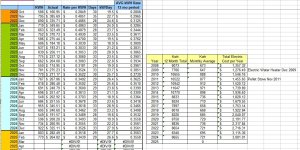Looking at the final number on your bill is misleading, if you're doing comparisons. Even dividing the total of the bill by your kwh used is misleading in most places. There are going to be flat fees, no matter how much you use. Say you have a flat fee of $10, and your electricity cost $0.10 per kwh. If you only use one kwh during the month, your bill is $10.10, making it look like you're paying over $10 for every kwh. But, if you use 1,000kwh, your bill is $110 or $0.11 per kwh. In reality, your electricity cost the exact same, but the flat fees are skewing the numbers. There's also some places that charge more depending on the time of year and/or the time of day. A while back, I tracked down all the different components that determined how much I would pay, and it was very complicated. I had to read through probably 20 different legalese type contract documents to put together all the different things. In the end, you have to pay everything, so it may not really matter. But if you're trying to understand what you're paying and compare it to other people, in terms of kwh costs, you should factor these things in. This also makes it appear that your electricity rates are increasing if you start conserving electricity (use fewer kwh, so the flat fees start impacting the apparent per kwh cost).
My "average" cost, just dividing bill by usage, ranges from $0.0093 to $0.012 (EDIT: That should be "ranges from $0.093 to $0.12"), depending on how much i use. This last bill was unexpectedly high usage (60% more kwh used than same period last year), so I'm currently trying to track down if I have a malfunctioning piece of equipment. This is in southeast va. While we did have a couple cold snaps, the average temp is not that different than it was last year.
Keep in mind that prices aren't static. What you pay when you move in will go up over time, especially if the provider is using a generation technique frowned on by the govt (ie, coal). If you're concerned, you might want to call the
Scottish Power phone number to inquire about potential future increases. There's a coal-fired plant about 1/2 a mile from me that is going to shut down in a few years due to EPA regulations. Think electricity demand is going to decrease before that shutdown? pfft. they're still planting subdivisions and mixed used developments in this area. Each persons usage is going up, and they're bringing in more people. The power company is going to have to upgrade other nearby plants and their distribution, causing my costs to go up.
If you really want to control your costs, control your usage and look into solar. Dependent on where you are and how fancy you get, the break even time frame for a grid tied solar setup may only be a few years - less if you can use tax breaks (state, federal, and others).
Keith

